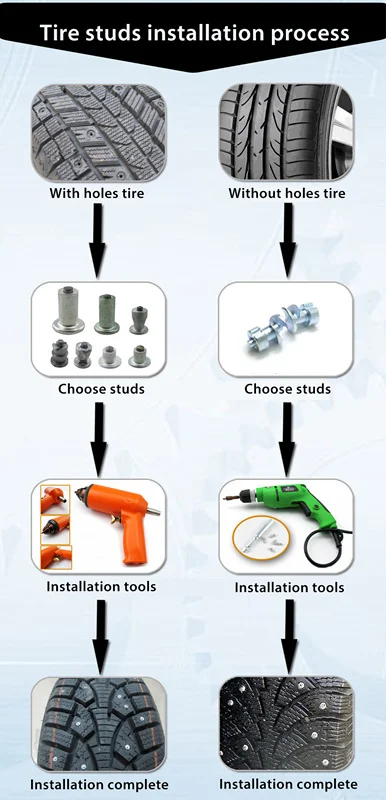Picking the perfect winter tire set can be a lengthy process. You need to know the answers to a couple of questions like what winter conditions you will be driving in or what is the state traction law regarding winter tires, even before your hunt begins.
It is important to purchase the correct winter tire set! These tires are designed to ensure your driving safety in the colder months. Therefore, what tires you get will differ depending on a couple of factors.
But, what is the difference between studded tires, studdable winter tires, and studless tire sets?
Let's find out the answer together!
Studded tires are a special type of winter tire, which features protrusions along their tread area. These small bulges are strategically placed on the tread area to increase traction on snow and ice surfaces.
Studded snow tires offer better grip, as studs clawing at the ice- and snow-covered surfaces generate additional biting edges. This significantly enhances their traction in winter conditions.
But, what are studs for tires?
Studdable winter tires use hard rubber studs or metal studs to further increase their winter weather performance. Studs are inserted into the pinned tread area, in order to generate additional biting edges.
Studs feature larger diameter cylindrical ends that have their roots inside the tread. Their top sports specially designed pins, that are taller than the footprint. You can purchase metal studs as well we hard rubber studs for tires.
Metal studs size chart:
Studdable winter tires are between studded and studless tires. They are sold with pinned tread areas, where studs can be inserted. Studdable snow tires are designed for versatile winter conditions.
You can add or remove studs from the tread area of studdable winter tires. However, doing it too often will damage the tire tread's integrity. Used tires cannot be studded to ensure their driving safety.
Used tires cannot be studded to ensure their driving safety.
Yet, there are new tire technology methods to stud, which have created removable tire studs that help to regulate winter weather performance.
Still, studdable winter tires allow drivers to make decisions for themselves about whether they want to stud their tires or not. While studding tires is a time-consuming process, keep in mind that you will need specific tire stud sizes for specific tire models.
It can happen that you will need to remove snow tire studs. When this happens, this is what you need to do:
Removing tire studs is not too difficult, but it is a timely process. You will need tire lubricant and a pair of pliers. Make sure the lubricant is safe to use for tires and that it does not damage its compound or tread area. Lubricate the studs on an inflated tire, and use the pliers to remove the studs by twisting them.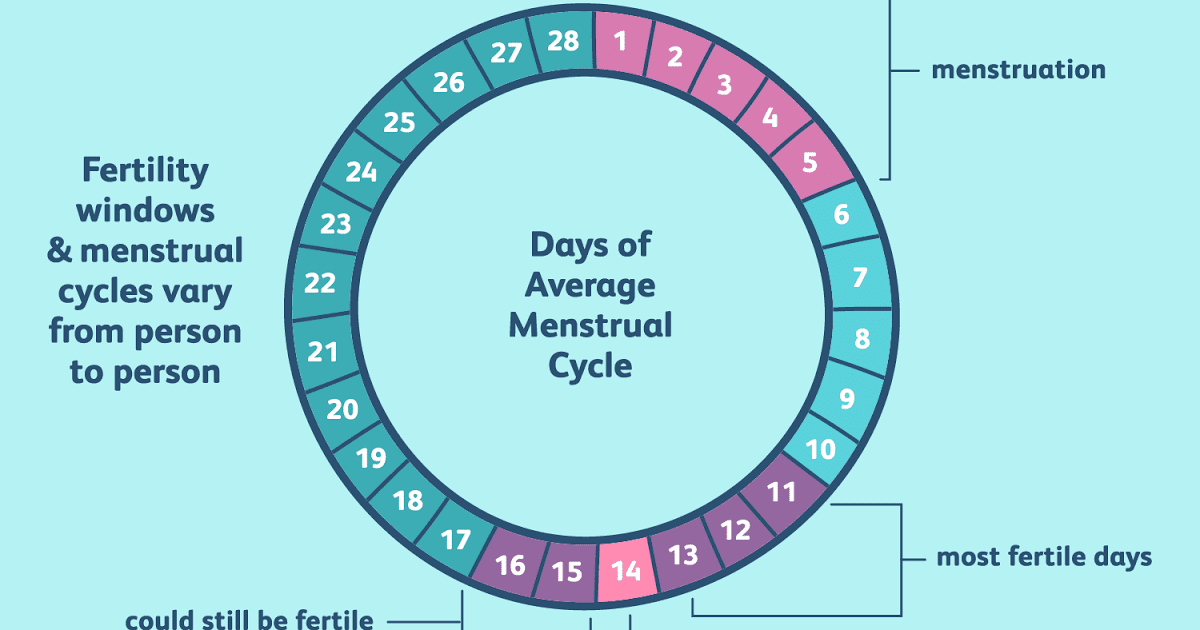
If you do not have time for this lengthy activity, you can also take your vehicle to a tire shop to have these car studs removed.
Compared to non-studded winter tires, studded tires offer a better grip on snow and ice. But, how exactly do winter tire studs work?
Studded tires provide extra grip during winter driving. Tire studs increase traction on icy and packed snow roads. This is due to the car studs gripping the driving surface, by breaking the top layer of ice.
Furthermore, the car weight helps winter tire studs installed on the tread area to increase traction as the tires rotate. This is something studded tires cannot provide.
However, this piercing ability is what makes studded tire laws necessary. But, we will talk about that later.
When it comes to the studded vs studless winter tires debate, it is important to what advantages these tires offer.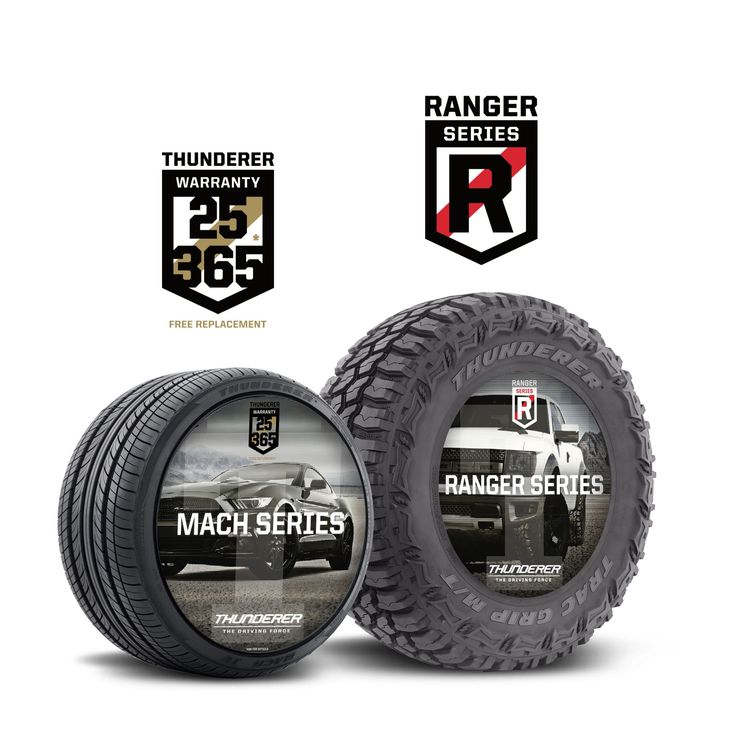 Purchasing a specific winter tire set for your needs is crucial to ensure your driving safety.
Purchasing a specific winter tire set for your needs is crucial to ensure your driving safety.
But, what do these winter tires offer? Let's take a closer look!
Studded tires were specifically designed for harsh winter conditions. Tires with metal studs are able to grip snow and ice-covered roads better, ensuring their forward motion and performance without slipping.
Snow tires with spikes provide superb traction on ice-covered hillside surfaces. Ice studs for tires guarantee the tire's performance even on uneven and unpaved roads. Unfortunately, studless winter tire sets are unable to provide the same.
You might also wonder how to get better traction in snow. Well, the answer is also studs, as long as we are talking about off-road surfaces. Packed snow can be easily conquered by studded tires, just make sure you follow state traction laws.
Studless winter tires provide better traction on paved road surfaces.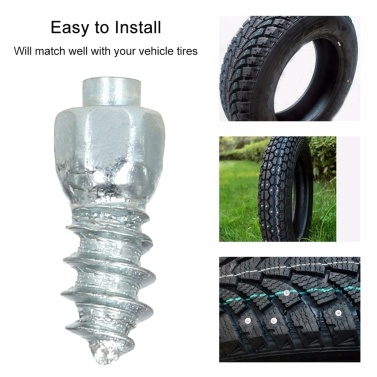 While they do not offer much help on hard-packed snowy surfaces, they conquer cold weather conditions.
While they do not offer much help on hard-packed snowy surfaces, they conquer cold weather conditions.
The detailed tread pattern of studless tires creates the necessary number of biting edges in order to increase its winter performance. Using studded tires on paved roads can damage roads easily, and for this reason, their use is highly regulated.
Thanks to the wide groove pattern of studless snow tires, hydroplaning is also minimized. These tires are able to channel water and slush from below the footprint, to further ensure driving safety.
When it comes to the studded tires vs snow tires debate, which tire set works for you greatly depends on where you live.
The question isn't a simple "when do studded tires need to come off?", it's more complicated than that. The use of studded tires is highly regulated by state law. In some states, tires with metal studs can only be used between specific dates, while other states completely outlaw them.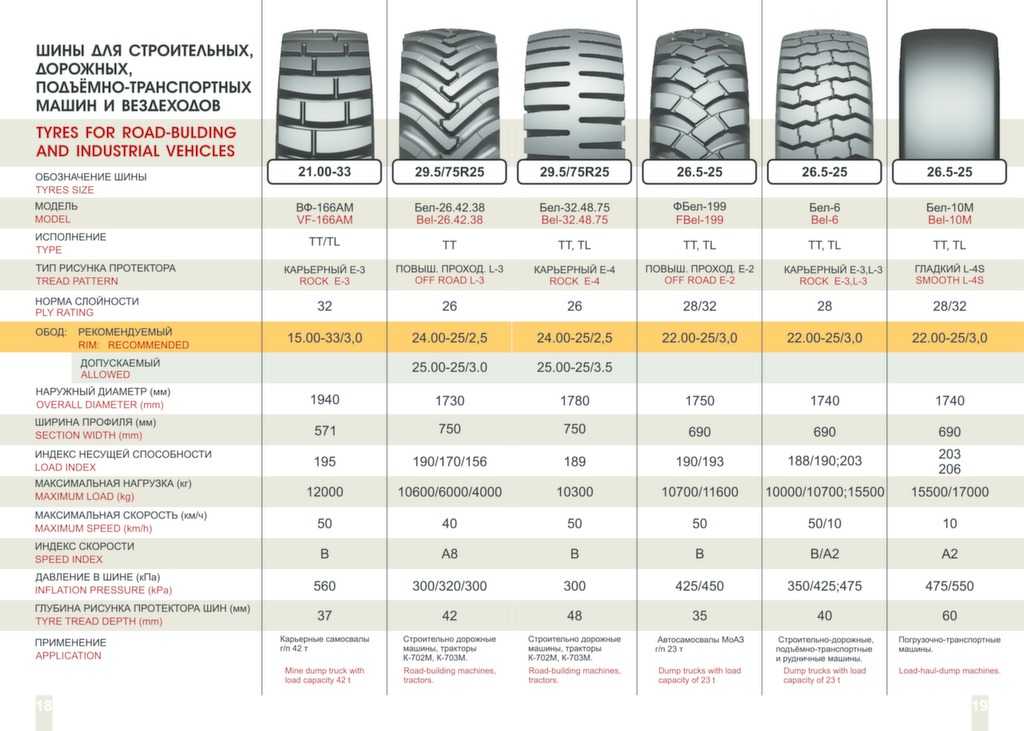 It all depends on where you are going to drive your vehicle.
It all depends on where you are going to drive your vehicle.
Whether you are restricted by dates, location within the state, or weather conditions, be sure you know what you sign up for when purchasing rubber or metal studded tires.
So, are studded tires worth it? You need to be the judge of that! But, before you decide, check below what your state allows.
Here are the studded snow tires laws by state:
| State | Laws for Stud Use |
| Alabama | The use of studded tires is only allowed when safety requires them on slippery road surfaces, as long as the studs are of reasonable proportion to the tires. |
| Alaska |
North of 60°
Latitude - The use of studded tires is allowed between September 16th - April
30th.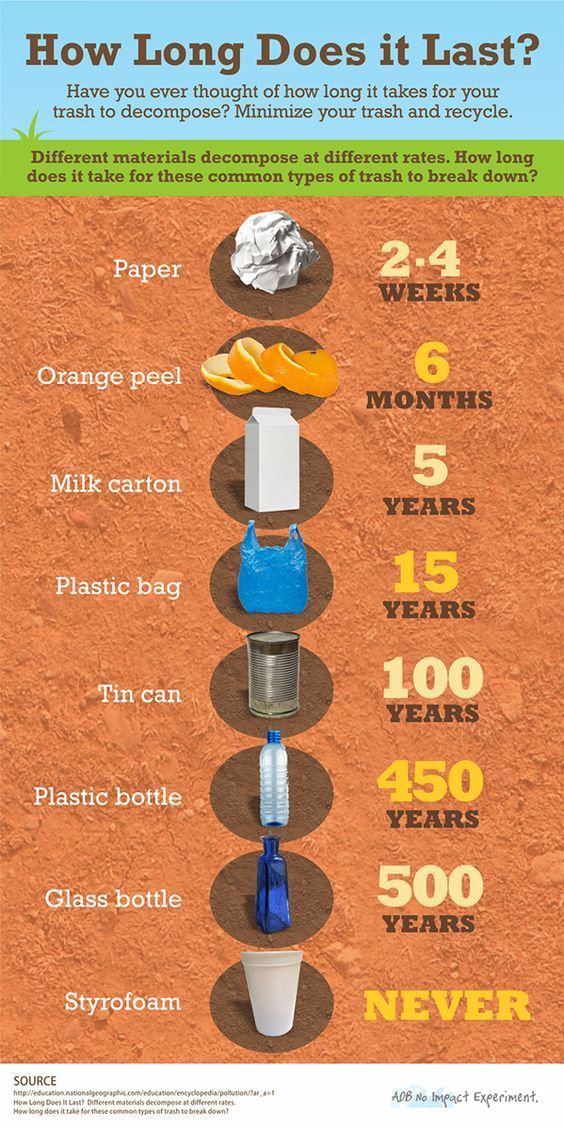
South of 60° Latitude - The use of studded tires is allowed between October 1st - April 14th. |
| Arizona | The use of studded tires is allowed between October 1st - May 1st. |
| Arkansas | The use of studded tires is allowed between November 15th - April 15th. |
| California | The use of studded tires is allowed between November 1st - April 30th. |
| Colorado | The use of studded tires is not allowed |
| Connecticut | The use of studded tires is allowed between November 15th - April 30th. |
| Delaware |
The use of
studded tires is allowed between October 15th - April 15th.
|
| Florida | The use of studded tires is not allowed |
| Georgia | The use of studded tires is only allowed when safety requires them on slippery |
| Hawaii | The use of studded tires is not allowed. Exceptions: the Mauna Kea access road above Hale Pohaku and on all roads within the Mauna Kea Science. |
| Idaho | The use of studded tires is allowed between October 1st - April 30th. Exception: Fire departments. |
| Illinois |
The use of
studded tires is not allowed. Exceptions: Rural mail carriers and persons
with disabilities living in unincorporated areas are allowed to use studded
tires between November 15th - April 1st.
|
| Indiana | The use of studded tires is allowed between October 1st - May 1st. |
| Iowa | The use of studded tires is allowed between November 1st - April 1st. |
| Kansas | The use of studded tires is allowed between November 1st - April 1st. |
| Kentucky | The use of studded tires is allowed. |
| Louisiana | The use of studded tires is not allowed |
| Maine | The use of studded tires is allowed between October 2nd - April 30th. |
| Maryland |
The use of
studded tires is allowed between 1st - March 31st for vehicles registered in
the following counties only: Allegany, Carroll, Frederick, Garrett, and
Washington.
|
| Massachusetts | The use of studded tires is allowed between November 2nd - April 30th. |
| Michigan | The use of studded tires is not allowed. |
| Minnesota | The use of studded tires is not allowed. Exception: Rural mail carriers are allowed to use studded tires on certain road conditions between November 1st - April 15th. |
| Mississippi | The use of studded tires is not allowed. |
| Missouri | The use of studded tires is allowed between November 2nd - March 31st. |
| Montana | The use of studded tires is allowed between October 1st - May 31st. |
| Nebraska |
The use of
studded tires is allowed between November 1st - April 1st.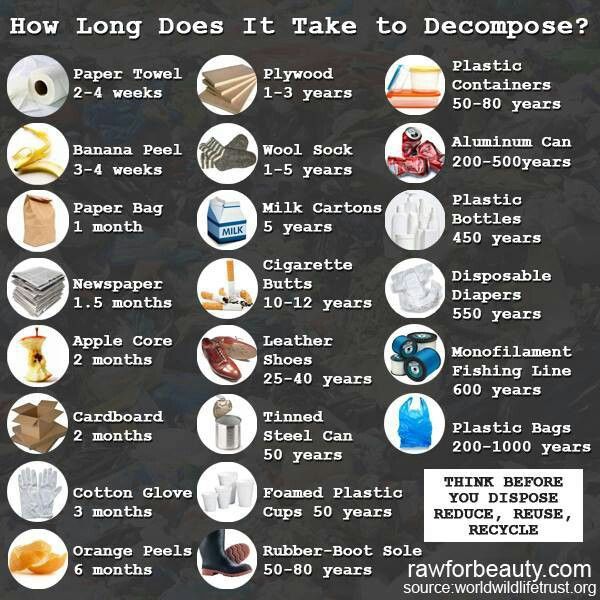
|
| Nevada | The use of studded tires is allowed between October 1st - April 30th. |
| New Hampshire | The use of studded tires is allowed. |
| New Jersey | The use of studded tires is allowed between November 15th - April 1st. |
| New Mexico | The use of studded tires is only allowed when safety requires them on slippery road surfaces. |
| New York | The use of studded tires is allowed between October 16th - April 30th. |
| North Carolina | The use of studded tires is allowed. |
| North Dakota |
The use of
studded tires is allowed between October 15th - April 15th. Exception: School
buses. Exception: School
buses.
|
| Ohio | The use of studded tires is allowed between from November 1st - April 15th. |
| Oklahoma | The use of studded tires is allowed between from November 1st - April 1st. |
| Oregon | The use of studded tires is allowed between from November 1st - March 31st. |
| Pennsylvania | The use of studded tires is allowed between from November 1st - April 15th. |
| Rhode Island | The use of studded tires is allowed between from November 15th - April 1st. |
| South Carolina | The use of studded tires is allowed |
| South Dakota |
The use of
studded tires is allowed between October 1st - April 30th. Exception: School
buses and municipal fire vehicles. Exception: School
buses and municipal fire vehicles.
|
| Tennessee | The use of studded tires is allowed between October 1st - April 15th. |
| Texas | The use of studded tires is not allowed. |
| Utah | The use of studded tires is allowed between October 15th - March 31st. |
| Vermont | The use of studded tires is allowed. |
| Virginia | The use of studded tires is allowed between October 15th - April 15th. |
| Washington | The use of studded tires is allowed between November 1st - March 31st. |
| West Virginia |
The use of
studded tires is allowed between November 1st - April 15
th, but only
on tires operating at 40psi or below.
|
| Wisconsin | The use of studded tires is not allowed. Exception: Emergency vehicles, school buses, and mail delivery vehicles. |
| Wyoming | The use of studded tires is allowed. |
You need specific stud sizes for specific tires. After that, you can use a tire studding kit or a tire stud gun and tire lubricant.
The tire pins need to be lubricated in order for the tire studs to be inserted. You can use tire screws or a tire studding tool to add studs to the tread area. However, be careful. Studs need to be inserted correctly, or they will just cause additional problems. Yes, there is an answer to "how to stud tires correctly?".
Depending on their depth, studs can be inserted in the following ways:
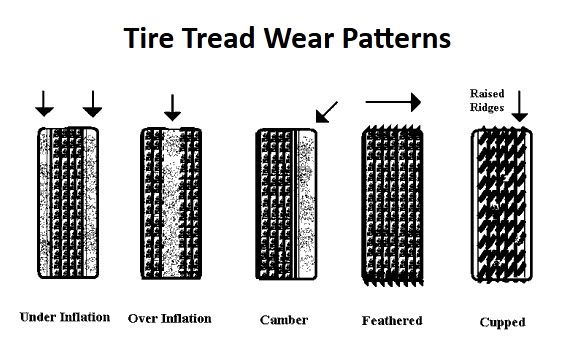
Additionally, tire studs should be inserted at 90-degrees. Anything more than a 10-degre difference will hinder the studded tires' winter performance.
Well, some studded winter tires are rated for over 100 mph. Yet, since they are made to be used on snow and ice, they should not be driven faster than 40 mph. This is because faster driving in deep snow and on icy roads can become dangerous. Additionally, these tires need a break-in period to safely perform.
Winter tires are designed to be used in below 45 degrees Fahrenheit. When temperatures drop below this, winter tires can be safely mounted and used on vehicles. Due to their special rubber compounds, winter tires should only be used in winter weather.
When temperatures drop below this, winter tires can be safely mounted and used on vehicles. Due to their special rubber compounds, winter tires should only be used in winter weather.
When you can use studded winter tires greatly depends on where you live. Some states without snow do not permit the use of studs at all or with some exceptions. Other states have specific dates when studded tires can be used on the vehicle. Check your state laws to know if you can use such tires or not.
Studded tires have no set life expectancy, as their performance depends on many factors. However, as long as the tires with winter tire studs are operated correctly (only on ice and packed snow-covered road surfaces), they will last for about 5 to 6 seasons.
While there's no set "life expectancy" for studded tires, many tire makers prove that you ought to get four periods of wear from a lot of studded tires. Track wear on winter tires will rely vigorously upon what number of miles you drive every month, and whether those miles are essentially on day off ice secured streets. Or if you routinely have a blend of day off solidified dry streets.
Track wear on winter tires will rely vigorously upon what number of miles you drive every month, and whether those miles are essentially on day off ice secured streets. Or if you routinely have a blend of day off solidified dry streets.
The track will wear all the more rapidly if the tire is running on freezing street surfaces than if they are on snow for a large part. Low mileage drivers will get any longer use out of their winter tires than drivers who have both long winters and drive long separations. The life expectancy of your tire will likewise be legitimately identified with the first nature of the tire, and the degree of care they're given.
People often get studded tires when winter comes
To clear up your queries about how long do studded tires last, we have picked up the most asked and give a brief answers for you. Let’s check out!
Studded tires are intended to be installed on studdable winter tires.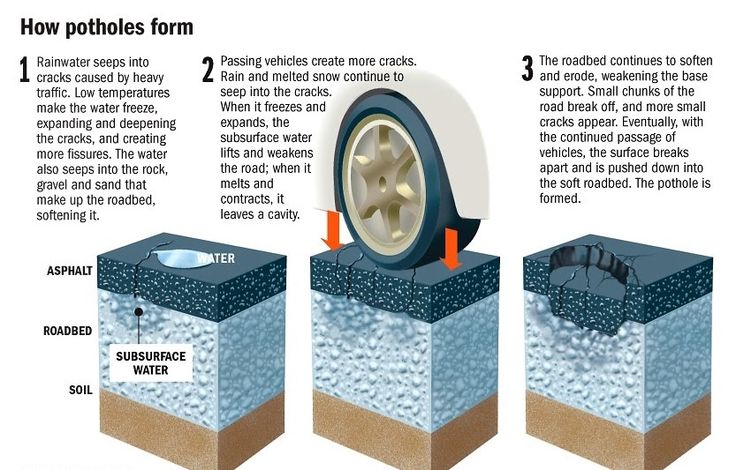 They work to enhance footing in select winter conditions. Studdable winter tires are sold without studs. They should be gained and installed independently.
They work to enhance footing in select winter conditions. Studdable winter tires are sold without studs. They should be gained and installed independently.
Studded tires have a huge distance across round and hollow end that roots down into the tire track. Also, they create a little tungsten carbide pin that stretches out from the "dynamic" finish of the stud. Hard elastic studs are likewise accessible.
Once installed, the top pin of the stud stretches out past the outside of the tire track by around 1/32", and attempts to enter solidified roadways to give additional hold. Let’s think about studs pounding and tearing into solidified precipitation under wheel turn.
Just studdable winter tires can have studs installed. These tires have been built with preset areas (gaps) for the studs. Endeavoring to stud studless tires could cause auxiliary integrity issues, and jeopardise the performance and security of the tire.
Like normal tires, studded tires wear out as well.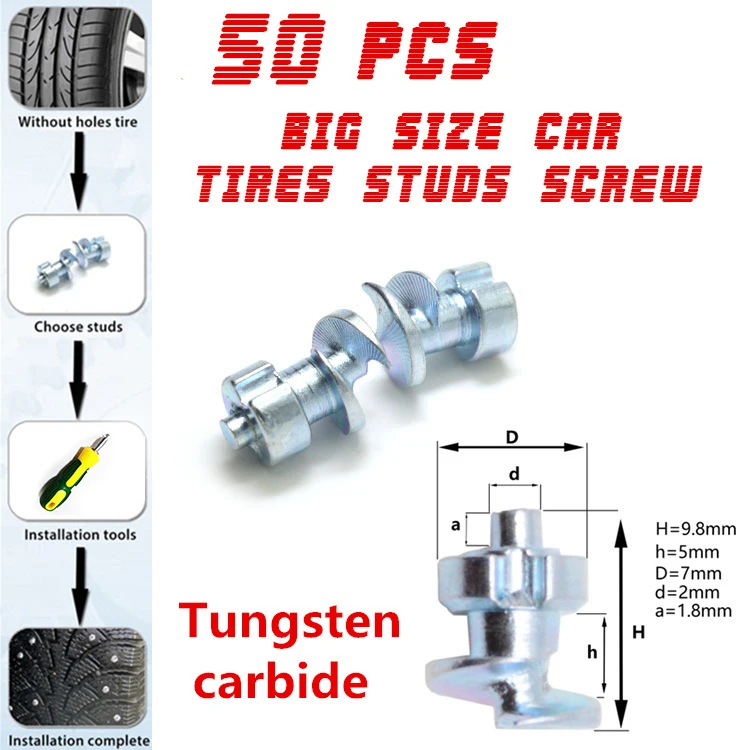 That is the reason you can just put studs on new tires that have never been utilized. You can't put a stud nor re-stud tires which were at that point driven on in light. Because it may cause genuine tire harm from erroneous stud lengths or flotsam and jetsam that were caught under the stud.
That is the reason you can just put studs on new tires that have never been utilized. You can't put a stud nor re-stud tires which were at that point driven on in light. Because it may cause genuine tire harm from erroneous stud lengths or flotsam and jetsam that were caught under the stud.
Studs typically last 20-30K miles before they become futile
Tire studs wear out as they are driven on frigid surfaces. The pins on studded winter tires wear a little more slow than the metal housings around them holding the stud's productivity to keep on running on a frosty surface.
Be that as it may, when a winter studded tire's track wears out to roughly 5/32", the studs step by step lose viability in running on profound day off. Studded winter tires are viewed as destroyed when the track profundity is underneath six mm.
Here are a few signs that will disclose to you when studded tires have worn out:
Any cut on your tire that estimates 1/4" can be fixed by the specialist.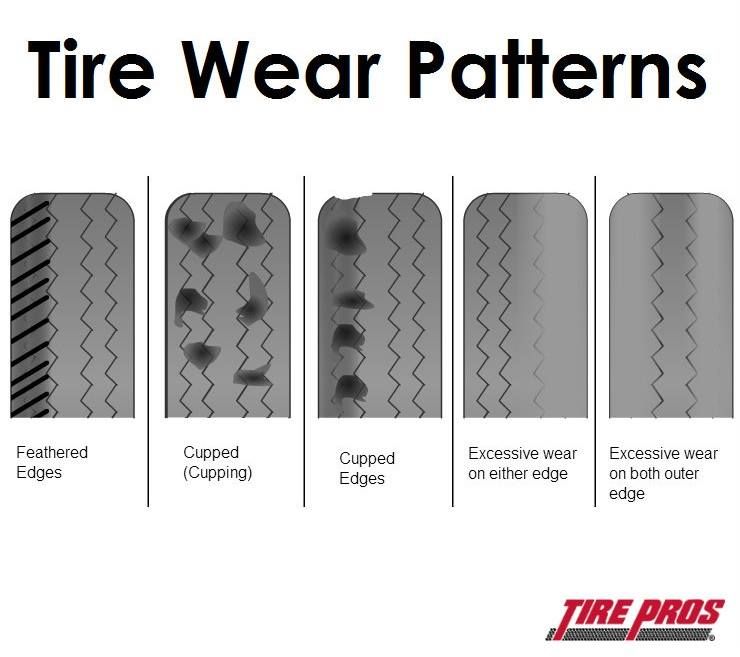 Notwithstanding, when you are out and about and can't contact any specialist, swap your tire with the extra to forestall further harm on the track.
Notwithstanding, when you are out and about and can't contact any specialist, swap your tire with the extra to forestall further harm on the track.
The necessary pneumatic force ought to consistently be followed to maintain a strategic distance from under-expansion or over-swelling that can harm your tire. The prescribed tire pressure is shown on the vehicle manual.
A lump flags the requirement for substitution. When a lump shows up superficially, it demonstrates that the tire's ropes are harmed as of now.
Studded winter tires have one demonstrated execution advantage over studless: Studded tires give predominant grasp on cold and hard-pressed blanketed streets.
Studded winter tires give an extra degree of hold since they're not simply interfacing with the street surface condition. The studs infiltrate solidified precipitation, and delve in like scaled down grapples.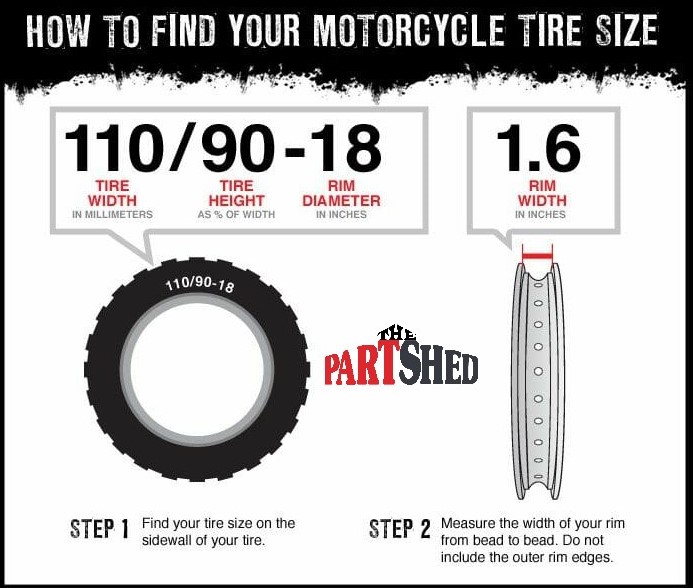
At the point when the driver quickens, brakes, or turns on ice with studded winter tires, the person has the joined bit of leeway of both the winter tire compound and studs pawing into the ice. This improves grasp and vehicle dealing with responsiveness.
Studded tires may reveal more cons than pros
Studs are extremely just favorable in frosty and hard-stuffed snow conditions. At the point when winter streets are dry or wet, studs really decline footing potential. In these conditions the tire track compound is the establishment of tire hold.
Studs are also known to create extra street commotion, including a ticking sound as the studs contact the asphalt. What's more, in frigid, slushy, or blended conditions, the footing points of interest of studs are negligible.
Another inconvenience is the cost that studs take on cleared streets. Studded tires additionally cause rutting of streets, particularly interstate thruways. This can prompt security issues like pooling water, hydroplaning, and other vehicle control issues.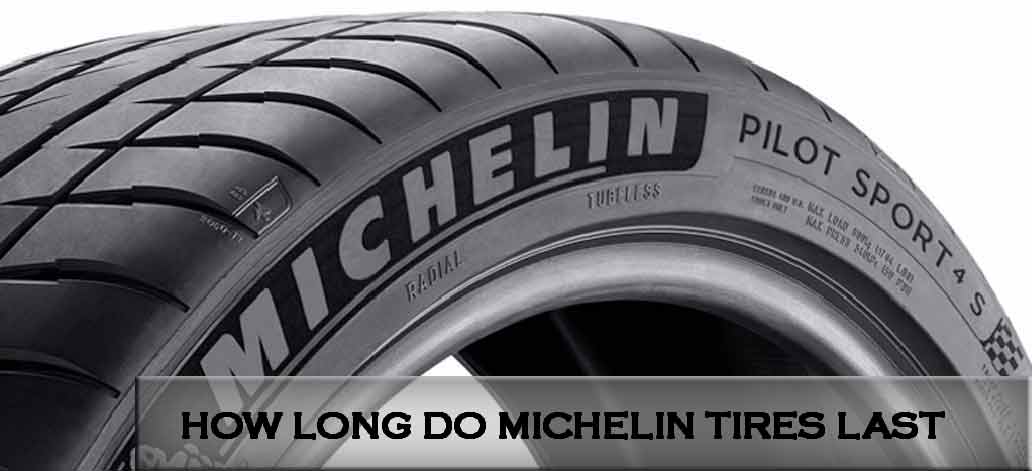
Are studded tires directly for you? As usual, the appropriate response relies upon the sort of driving you do the frequently, and your financial limit. Then, how long do studded tires last? We may not have a specific number, but from all the factors that combined, everyone has their own answer.
11/01/2022
A lot depends on the condition of the rubber. Just like any other automotive product, these tires also have their own lifespan. There are also a number of factors that should be taken into account operation, ranging from quite natural wear and tear, and ending with the loss of technical characteristics tires.
Studies have shown that winter studded tires have a shorter life than summer tires. And also this the indicator may differ from those products that do not have spikes. Consider how many seasons winter is designed for studded rubber.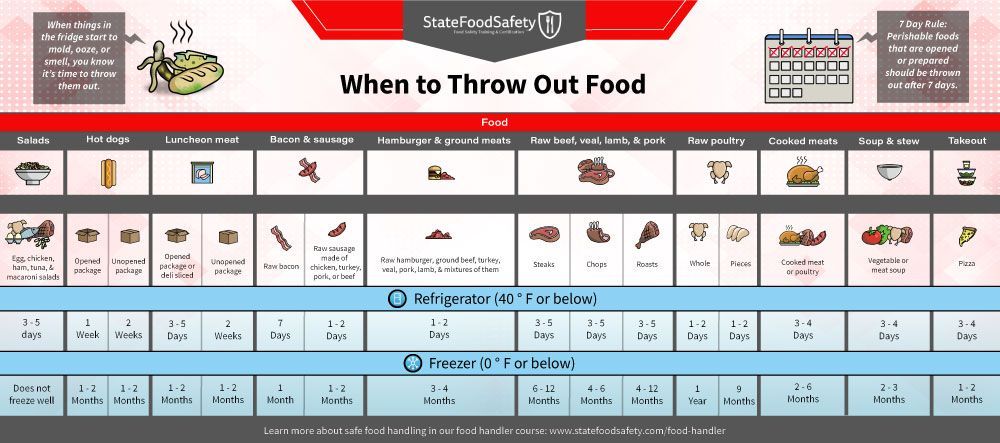
Once again, it should be noted that the winter version is different from the summer one. Although outwardly they are very similar, but in specifications are very different. For example, the summer version is tougher, while the winter one is softer and more elastic. This means winter tires wear out faster.
How long can studded winter tires be used? It depends on many indicators. For example, if products improperly stored and operated, wear will accelerate. That's why when buying tires you should pay attention to some of their features.
The first thing you should pay attention to is new tires or used ones. In the latter case, you need to understand who is the tire manufacturer and when they were released. This will allow you to understand how much more such tires can withstand. If we are talking about models with spikes, then this factor should be given special attention.
To determine how long studded winter tires last, all models should be divided into more expensive and more expensive. cheap analogues. For example, if we are talking about branded products, then their service life is much longer. How Can you drive with winter tires? If the model is chosen correctly, maximally adapted to the brand of the car, is installed taking into account tires, then the service life is 5 years or more.
cheap analogues. For example, if we are talking about branded products, then their service life is much longer. How Can you drive with winter tires? If the model is chosen correctly, maximally adapted to the brand of the car, is installed taking into account tires, then the service life is 5 years or more.
Another thing is cheaper analogues, which include some cheap domestic or Chinese models. They are under the same conditions, they can serve only a couple of seasons. The reason is that expensive models have patented components, thanks to which the rubber does not age and feels great even after five years. But in cheaper models, there are usually no such components, which means they crack faster and lose elasticity.
To achieve these conditions, it is necessary that the tires be stored at a temperature in the region of zero, they must be constantly maintain the desired pressure, and you need to drive at low speed on ice or snow, but not on sand, which usually sprinkle roads in winter. In other words, such conditions are necessary for which the studded winter tire is designed tire.
Another thing is if the tires were used aggressively, that is, there was active braking and abrupt starts. And the tires were used at temperatures from +8 degrees and drove on dry asphalt. In this case, the spikes quickly fly off, and tires wear out.
In addition to the service life, you should also pay attention to such an indicator as the shelf life. Despite the seeming similarity these indicators are somewhat different, and they need to be separated. In simple terms, the term service life depends on the operation, while the expiration date depends on the date of production.
Speaking by example, even if the tires are stored in the pantry and not used, they still age, and over time they will not be able to be used. Therefore, even if tires have simply been in storage for several years (from 4 years and more), then you should not hope that the tires will meet all the declared characteristics.
It turns out that if you are sold new tires, but they were stored incorrectly, then on the road such models will behave very noisy, and they will also lose their elasticity and begin to shrink.
Microcracks appear on the surface of the tires over time, which, with further use, will only increase. That's why tires that have been in stock for a long time are usually sold at big discounts, motivating this with the winter sale.
The storage of the material is also of no small importance. You can not let the sun constantly fall on it, indoors was high temperature and humidity. Also, products should be stored in completely sealed packaging so that there is no air got in.
If all these conditions are not observed, then the rubber will become less elastic, microcracks will appear on it due to the fact that that she will shrink. But if the storage is carried out correctly, then in a couple of years the rubber will not lose its properties. If you do not do this, then the tires will be unsuitable for further use.
To understand exactly when the rubber was made, you should look at the presence of the marking. The numbers are applied on the side, and they are made up of four numbers. These numbers indicate the date of manufacture of the product.
If you add up all that has been said above, the time it takes to use winter tires depends on the following indicators:
If tires are used incorrectly, the use time will increase, but the conditions under which tires used, and mileage.
Consumer disputes over the age of tires have not subsided for several seasons. Buyers are excited that the warranty period for tires is limited to 5-6 years according to GOST, and after the expiration of this period, the rubber becomes unusable.
Is this really the case, read this article.
Manufacturers of most brands for their products set shelf life - 5 years and the service life is also 5 years .
The shelf life of a tire is the period during which it retains its performance when properly stored.
The end of this period does not mean that the tires have become unusable . A shelf life of 5 years is given by manufacturers because, by law, they cannot set a shelf life higher than the service life. Tires over 5 years of storage cannot be called damaged or defective, their technical characteristics may be slightly reduced. American researchers argue that the period of storage of "shoes" must be at least 10 years. Experts from Germany are sure that it cannot exceed 6 years.
American researchers argue that the period of storage of "shoes" must be at least 10 years. Experts from Germany are sure that it cannot exceed 6 years.
The expiration date of tires is the warranty period during which the manufacturer is responsible for the quality and condition of the tire if it was used for its intended purpose without violating the operating rules.
According to Russian legislation (GOST 5513, GOST 4754-97) , the service life of tires is 5 years from the date of manufacture.
How can I find out the date of manufacture of tires?
You can find out the age of tires by a special DOT code. Tires manufactured after 2000 in the DOT code contain two pairs of numbers, where the first pair indicates the week number of the year, and the second pair indicates the year. Earlier tires before 2000 have 3 numbers in their composition, where the first two digits are the week number, and the last one is the year (see the transcript in the photo).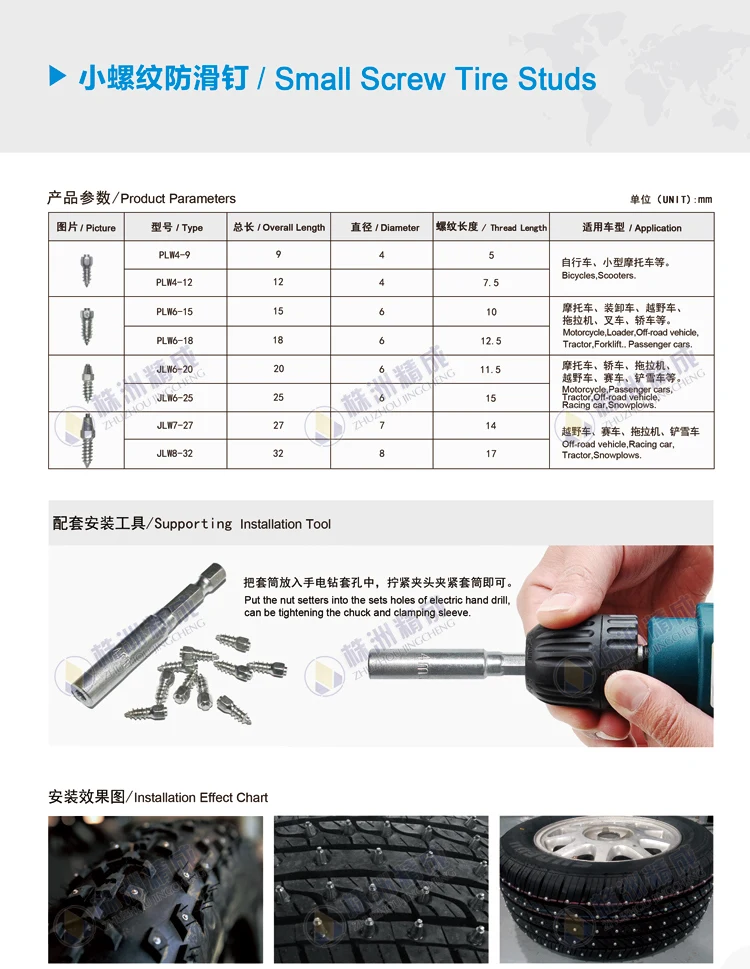
Determination of the average shelf life of a tire according to GOST and operating conditions.
- The symbol ZR denotes tires for high-speed cars. They are recommended to be used at speeds over 240 km/h. up to 6 years
- Tires with the H symbol are used at a maximum speed of 210 km/h. within 5 years.
- The sign S symbolizes the maximum permissible speed of 180 km/h. and operational period of 4-5 years.
Most tire manufacturers do not agree that tire life is limited to 5 years. Each company has its own opinion on this matter. We analyzed several of them and the information they posted on their official websites.
Michelin
The French tire manufacturer Michelin has become famous for its active fight against the perception of the rapid aging of tires as a perishable product. Her information campaign "Tires Are Not Bananas" created a lot of noise in the automotive environment. According to the representative office, several test trials were carried out in Saudi Arabia, South Korea and Germany. As a result of testing, no difference was found between new tires and tires stored for 3 years. They were tested for various characteristics such as rolling resistance, high speed durability, etc. Tires with a year life were approximately equal in performance to 10-year unused tyres.
According to the representative office, several test trials were carried out in Saudi Arabia, South Korea and Germany. As a result of testing, no difference was found between new tires and tires stored for 3 years. They were tested for various characteristics such as rolling resistance, high speed durability, etc. Tires with a year life were approximately equal in performance to 10-year unused tyres.
Michelin focuses the attention of car owners on the fact that tires are not a perishable product, their shelf life is not as important as the service life is important, starting from the date the tires are installed on the rims. It is from this moment that the tire is subjected to all tests: pressure, temperature changes, wear, contact with uneven and sharp coatings, etc.
Continental
On the Russian official website of Continental, we found the following information on the expiration dates of tires.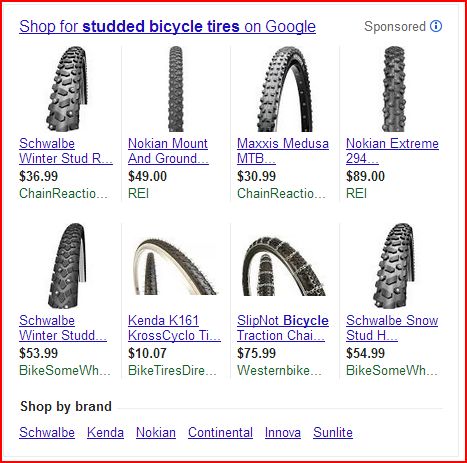
“When a tire is stored in the correct position and under the recommended conditions, it will not lose its original balanced performance for 5 years from the date of manufacture of the tire.
A properly maintained, unused tire less than 5 years old can be sold as a new tire and used normally.
Continental recommends replacing all tires (including spares) with a sidewall date greater than 10 years.
Nokian
The following information is posted on the Nokian official website:
“Tire life is not defined by law, but tires can only be considered “new” if they have been manufactured within the last five years. The recommended service life of tires is six years and the recommended maximum period is 10 years.
The opinion of our specialists, based on many years of experience, coincides with the opinion of manufacturers: the shelf life is 5 years + the service life is up to 10 years. Moreover, more "adult" tires, in our opinion, are of better quality.
To keep tires as long as possible, they are stored in compliance with all rules and recommendations. The main condition is a cool, ventilated, darkened room away from oils, paints, ozone, and heat sources.
Rubber products tend to lose their performance over the years. To prevent and slow down this process, manufacturers add polymers to the rubber compound. They prevent oxidative processes that occur due to the interaction of protectors with oxygen and ozone.
The following are the main conditions for the proper storage of tires in accordance with GOST 24779-81:
Maintaining a constant regime without sudden jumps, slight temperature fluctuations from -30°С to +35°С are allowed;
Provide a low humidity level of 50-80% in a dry, ventilated cool room;
Avoid direct sunlight, use darkened hangars, shield heat sources;
Keep away from sources of heat;
Tires should not come into contact with corrosive, copper materials.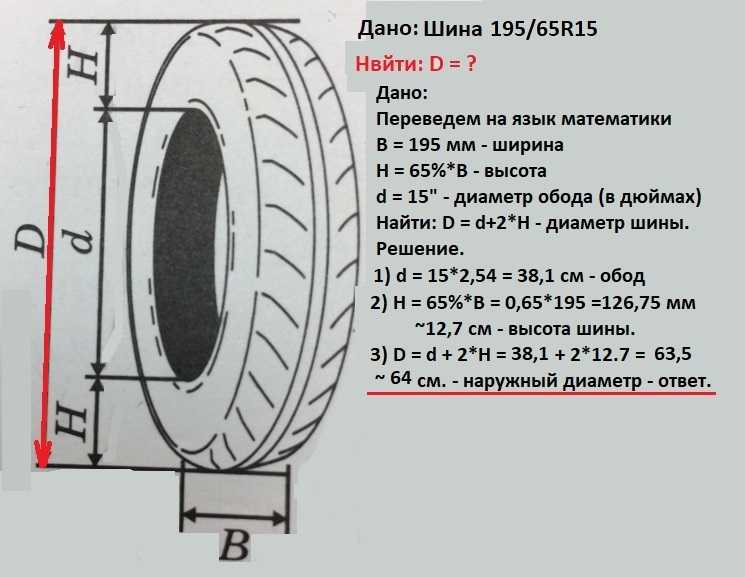
Avoid kinking, loading or positioning on an uneven surface.
Avoid contact with oils, organic solvents, acids, alkalis, fuels and lubricants on the tire surface. It is forbidden to lay tires on a wet and dirty surface.
In the warm season, when storing tires outside, they should be covered with light-tight material and raised above ground level to ensure ventilation and prevent the occurrence of the greenhouse effect.
Storage on reflective, light and heat absorbing surfaces is prohibited.
Keep away from chemicals, oils, paints, open flames, electric motors that produce ozone.
Used tires must be washed and dried.
Tires without rims should be stored upright.
The service life depends on many factors: the load on the car, the quality of the roads, the driving style, the distance traveled, tire damage, etc.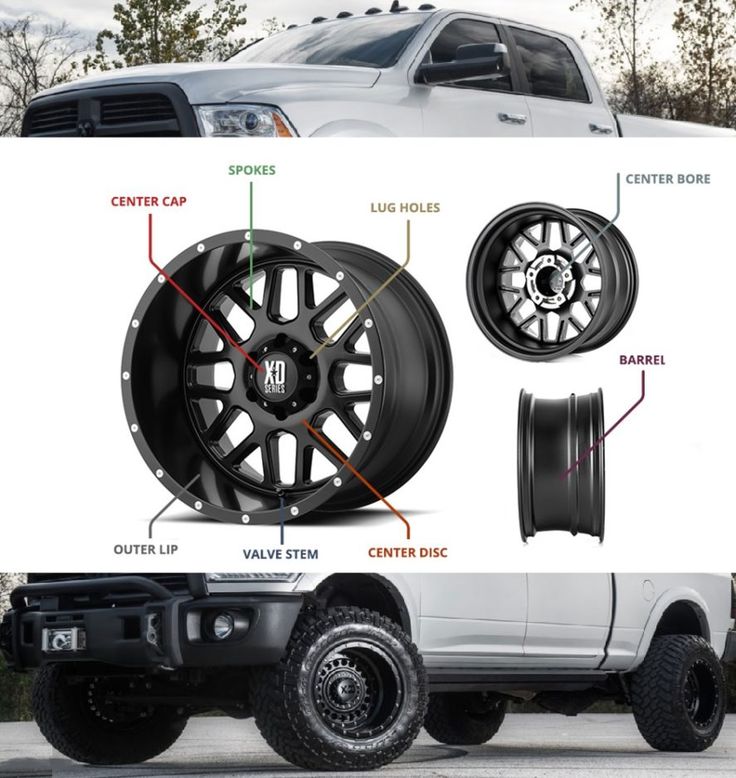 To increase their service life, follow these rules:
To increase their service life, follow these rules:
Check tire pressure every 2-3 weeks. With reduced pressure, tire wear increases by the equivalent of a % reduction. For example, a 15% reduction in pressure can result in a 15% reduction in service life. Inflated tires are less scary.
The wear of the front tires is always significantly higher than the rear ones, so it is recommended to swap them after some time, carefully watching the direction of the tread pattern and the direction of rotation.
Proper alignment of tires in relation to rims. If the direction is not the same, then performance is significantly reduced.
To prevent damage to the sidewalls of tires, avoid close proximity to curbs and high ledges.
Wash off dirt from the surface of the rubber and from deep grooves with special cleaning agents.
Adhere to an even driving style without harsh brakes and quick starts.